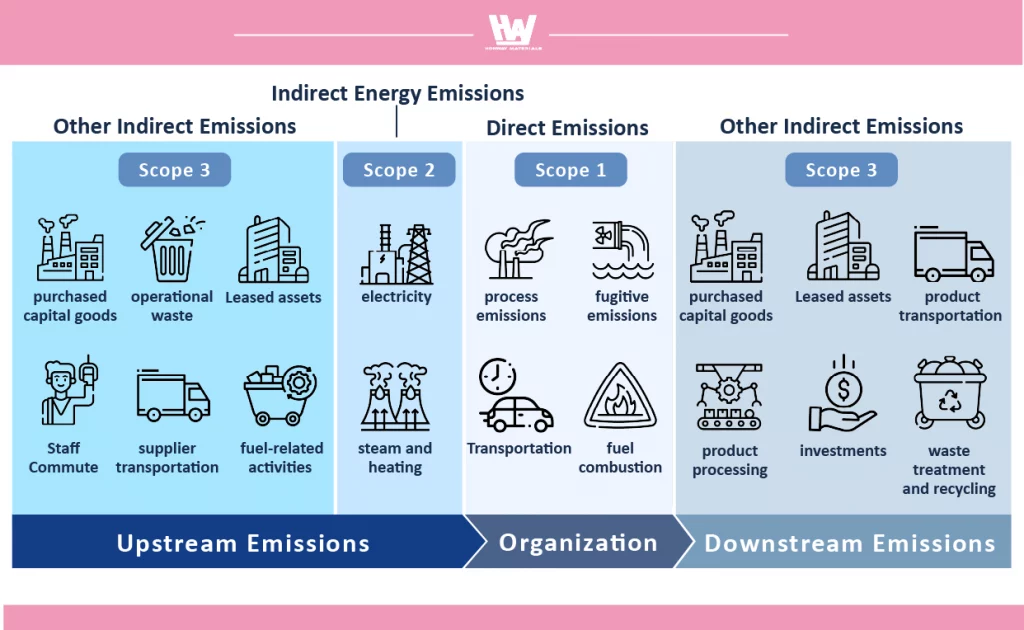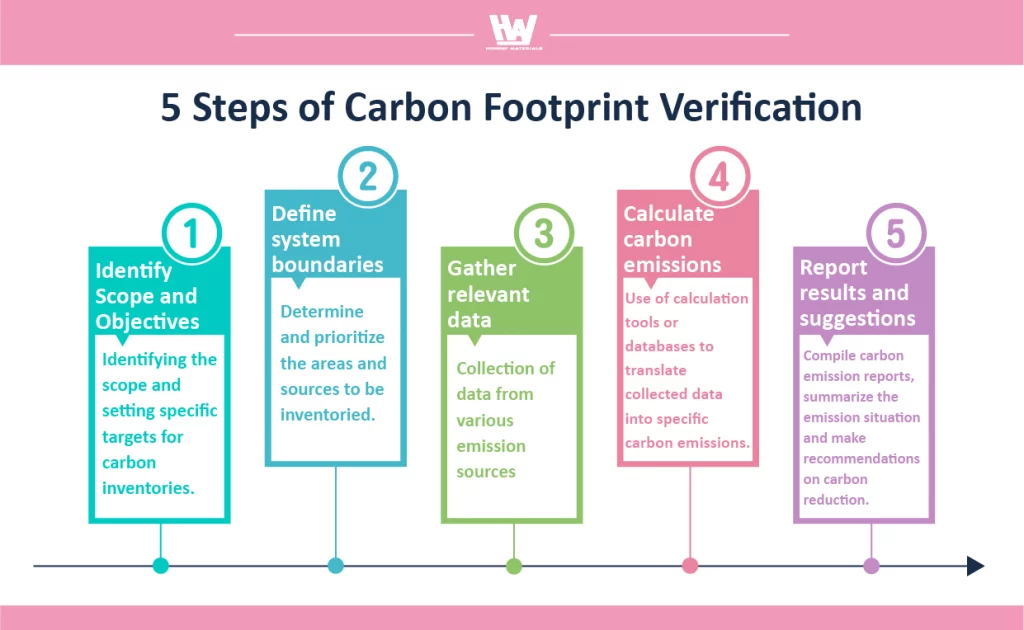Table of Contents
What is Carbon Footprint Verification?
Carbon footprint verification (CFV) is a method to quantify and track the greenhouse gas emissions produced by companies, organizations, or individuals. This process aims to understand the emissions of carbon dioxide and other greenhouse gases, such as methane and nitrous oxide, generated by a specific activity, product, or operation over a period. The results of Carbon footprint verification are typically expressed in “carbon dioxide equivalent” (CO₂e), allowing different greenhouse gases to be converted into a common metric for easier comparison and management.
What’s the Difference Between Carbon footprint Verification and Carbon Footprint?

Carbon Footprint Verification: This is a broader process encompassing the total greenhouse gas (GHG) emissions inventory, typically applied to entire entities like companies, organizations, cities, or even nations. The purpose of carbon footprint verification is to gain a comprehensive understanding of the GHG emissions across the entire entity, rather than just for a single product. Emissions are commonly categorized into three scopes—Scope 1 (direct emissions), Scope 2 (indirect energy emissions), and Scope 3 (other indirect emissions)—to help organizations understand and manage their overall carbon emissions.
Carbon Footprint: This term usually refers to the total greenhouse gas emissions generated, both directly and indirectly, by a specific product, service, or activity over its entire life cycle. It is calculated per unit of a product or service and includes emissions from all stages, such as raw material extraction, manufacturing, use, and disposal. For instance, the carbon footprint of a bottle of milk would include emissions from raising the cows on a farm, transporting the milk to consumers, and packaging disposal.
In summary:
Carbon footprint verification: Focuses on assessing and managing total emissions, primarily for evaluating an organization or company’s overall emissions.
Carbon footprint: Focuses on the carbon emissions of a single product, service, or activity, primarily used in product lifecycle analysis.
What Are the Scopes of Greenhouse Gas Assessment? What Are Scope 1, 2, and 3?

Scopes 1, 2, and 3: These are the three main classifications of GHG emissions used in carbon footprint assessments for organizations. Established by the Greenhouse Gas (GHG) Protocol, this categorization helps entities systematically understand and manage the sources of their GHG emissions.
Scope 1: Direct Emissions
Refers to greenhouse gas emissions directly generated by the organization, meaning emissions from sources the organization owns or controls.
Examples include fuel combustion in company vehicles, process emissions, fugitive emissions, and refrigerant leaks.
Scope 2: Indirect Energy Emissions
Refers to indirect emissions resulting from energy purchased by the organization, such as electricity. While these emissions originate from external providers, they are considered indirect emissions because they stem from the organization’s energy consumption.
Such as electricity, steam, cooling, and heating.
Scope 3: Other Indirect Emissions
Refers to other indirect emissions from the company’s upstream and downstream value chain activities. Although challenging to control and quantify, these often represent a significant portion of an organization’s total emissions.
Scope 3 emissions often include sources that the organization has limited control over but still contribute substantially to overall emissions. Identifying and analyzing these sources helps organizations improve within a vast industrial network.
Upstream Emissions: Includes emissions from purchased capital goods, supplier transportation, fuel-related activities, and operational waste.
Downstream Emissions: Encompasses emissions from capital goods, product processing, product transportation, distribution, investments, waste treatment, and recycling.
Climate Change Mitigation and Emission Reduction: Carbon footprint assessments help organizations identify their emission sources and volumes, enabling targeted carbon reduction strategies. By reducing emissions, companies can lessen their climate impact and fulfill their environmental responsibilities.
Why Conduct a Carbon Footprint Verification?
Demonstrate Corporate Social Responsibility: Carbon management capabilities have become a key focus for investors, as more investment institutions integrate environmental, social, and governance (ESG) performance into their decision-making. Companies actively conducting carbon footprint assessments are more appealing to ESG investors, helping them attract greater investment.
Reduce Operational Costs: Carbon assessments assist companies in identifying areas of energy and resource waste. By reducing energy consumption and increasing efficiency, companies not only lower their emissions but also save costs and improve operational efficiency. For example, optimizing production processes or cutting down on energy usage directly reduces operational expenses.
Address Climate Change and Reduce Greenhouse Gas Emissions: Carbon assessments help companies understand their emissions sources and volumes, enabling them to craft targeted carbon reduction strategies. By decreasing emissions, companies mitigate their climate impact and fulfill environmental responsibilities.
Carbon Credit Trading: The carbon credit trading mechanism is a market-based approach to reducing emissions by turning carbon quotas into tradable assets, thereby incentivizing nations and companies to cut emissions. The principle behind it is that entities or countries with low emissions can sell their unused carbon credits to those exceeding their emissions cap, thus achieving economic benefits while promoting emission reductions.
How Can Companies Conduct Carbon Footprint Verification? 5 Steps to Get Started

Taiwan uses CNS-14067 as the standard for conducting carbon footprint assessments. Companies can carry out the assessment process by following these five steps:
Step 1: Define organizational boundaries and objectives for the carbon assessment.
Organizations need to first define the scope of their carbon footprint assessment, specifying whether it will cover Scope 1 (direct emissions), Scope 2 (indirect energy emissions), and Scope 3 (other indirect emissions).
Setting clear objectives for the assessment ensures that the scope aligns with the organization’s carbon reduction needs.
Step 2: Define system boundaries.
This step involves determining the assessment’s boundaries and emission sources, including the life cycle stages to include in the assessment.
By defining these boundaries and priorities, companies can streamline their focus on key emissions sources, thereby improving assessment efficiency and achieving better carbon reduction results.
Step 3: Gather relevant data.
Based on the defined scope, data is gathered from emission sources, such as energy consumption (electricity, fuel), waste disposal, usage of refrigeration equipment, and logistics emissions.
This information can be sourced from utility bills, logistics records, and supplier data.
Step 4: Calculate carbon emissions.
Convert the collected data into specific carbon emissions using suitable calculation tools or databases.
Emission data is usually converted into carbon emissions using emission factors (e.g., CO₂ emissions per kilowatt-hour of electricity) to calculate the total emissions across different scopes.
Step 5: Report results and improvement suggestions.
Summarize emissions across all scopes and provide carbon reduction recommendations.
The report should clearly outline the assessment’s scope, methodology, and results, as well as specific carbon reduction strategies, such as energy efficiency improvements, renewable energy use, and supply chain optimization, to help the organization meet its carbon reduction targets.
Benefits of Implementing Carbon Footprint Verification
1. Enhance Brand Image and Market Competitiveness: With consumers increasingly valuing environmental responsibility, a company’s active carbon reduction efforts bolster brand image, appealing to eco-conscious customers. Conducting and publicly sharing carbon assessments reflects a commitment to sustainability, which strengthens customer loyalty and competitive standing in the market.
2.Attract Investments and Capital: As ESG investments rise, more investors use a company’s carbon performance as a crucial factor in investment decisions. Carbon assessments and public disclosure of reduction efforts help companies attract ESG-focused investments and secure additional financial support.
3.Promote Technological Innovation and Green Technology Development: Carbon assessments encourage companies to closely analyze their emissions, leading to the adoption of new technologies that lower emissions. Implementing energy-efficient equipment, refining processes, or using eco-friendlier materials are examples of innovations that not only reduce emissions but also improve productivity and efficiency.
Conclusion
Carbon footprint verification is crucial for the sustainable development of companies, as it not only helps businesses evaluate their carbon footprint but also promotes reduced energy consumption, improved efficiency, and a positive market image. Amid the global trend toward carbon neutrality, carbon footprint verification has become essential in implementing Environment, Social, and Governance (ESG) policies for companies and organizations.
Honway focuses on physical polishing technologies and has rich experience in super-hard abrasives and rare-earth raw materials, dedicated to providing low-pollution polishing solutions to meet customers’ needs for environmental sustainability and high performance.
Action
- Learn what ESG is at once>>>What is ESG? What Benefit can ESG Bring to Companies? How to Implement ESG?
- Policy Context>>Countries around the world are pledging and taking action toward achieving “net-zero emissions by 2050.” Taiwan’s roadmap to net-zero by 2050 involves four major transformational areas—Energy Transformation, Industrial Transformation, Lifestyle Transformation, and Social Transformation—anchored by two foundational governance pillars: Technological Research and Development and Climate Legislation. Based on these transformations, Taiwan has crafted an action plan comprising twelve key strategic initiatives, focusing on energy, industry, and lifestyle sectors to drive the nation’s progress toward net-zero emissions.
- Evaluate whether the current manufacturing processes meet carbon reduction objectives.
- Assess if the existing polishing processes could be replaced with more carbon-efficient alternatives.
- How to implement
- Implement testing and review
Honway specializes in physical polishing, ultra-hard abrasives, and rare-earth materials, striving to provide polishing solutions with reduced environmental impact. If you have related needs or would like to learn more, please feel free to contact us! Let’s work together toward a sustainable future.
Customized Grinding Solutions: We offer tailored adjustments to our grinding processes, allowing us to meet specific processing needs for maximum efficiency.
After reading the content, if you still don’t know how to select the most suitable option,
Feel free to contact us and we will have specialist available to answer your questions.
If you need customized quotations, you’re also welcome to contact us.
Customer Service Hours: Monday to Friday 09:00~18:00 (GMT+8)
Phone: +8867 223 1058
If you have any topics you want to learn more about or if you find it difficult to explain over the phone, feel free to message us on Facebook.
Honway Facebook: https://www.facebook.com/honwaygroup

